
The 98th Infantry Division ("Iroquois") was a unit of the United States Army in the closing months of World War I and during World War II. The unit is now one of the U.S. Army Reserve's training divisions, officially known as the 98th Training Division. Its primary mission is to conduct Initial Entry Training (IET) for new soldiers. It is one of three training divisions subordinate to the 108th Training Command (IET) and handles command and control of units throughout the eastern United States and in Puerto Rico.

The Canadian Grenadier Guards (CGG) is a reserve infantry regiment in the 34 Canadian Brigade Group, 2nd Canadian Division, of the Canadian Army. The regiment is the oldest and second-most-senior infantry regiment in the Primary Reserve of the Canadian Army. Located in Montreal, its main role is the provision of combat-ready light infantry troops in support of Canadian regular infantry. It is a Household Foot Guard regiment and also provides soldiers for public ceremonial duties, performing similar ceremonial duties as the Guards regiments of the British Army. This primarily entails mounting the guard at Government House, the King's and Governor General's residence, and performing the "Changing the Guard" ceremony on Parliament Hill in Ottawa, a task it shares with Canada's senior Household Foot Guard regiment, the Governor General's Foot Guards of Ottawa. The Canadian Grenadier Guards is an allied regiment to the British Grenadier Guards.
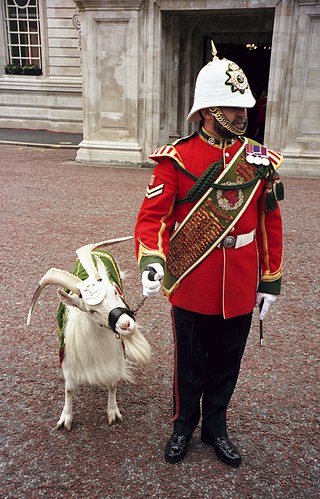
The Royal Regiment of Wales was an infantry regiment of the British Army, part of the Prince of Wales' Division. It was formed in 1969 by the amalgamation of the South Wales Borderers and the Welch Regiment. The 1st Battalion, The Royal Regiment of Wales had a short existence in military terms, just over 36 years. Within two months of amalgamation, the battalion was one of the first units to be deployed to Northern Ireland.
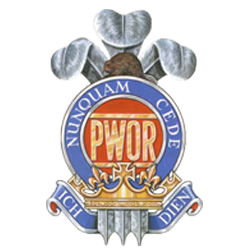
The Princess of Wales' Own Regiment (PWOR) is a Primary Reserve infantry regiment of the Canadian Army.

The Grey and Simcoe Foresters is a Primary Reserve infantry regiment of the Canadian Forces. Within the Canadian Army, it is part of the 4th Canadian Division's 31 Canadian Brigade Group. Due to the restructuring of the British Army, The Worcestershire and Sherwood Foresters Regiment was amalgamated into The Mercian Regiment, as its 2nd Battalion, leaving The Grey and Simcoe Foresters as the only remaining unit in the Commonwealth of Nations known to be distinctly designated as a regiment of Foresters.
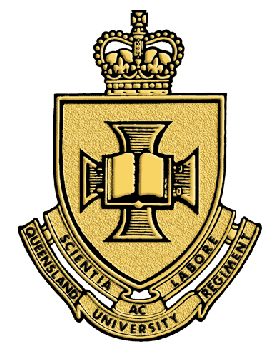
Queensland University Regiment (QUR) is a training unit of the Australian Army Reserve. Based in Queensland, the regiment is currently assigned to the 8th Brigade. The regiment's history can be traced back to 1932 when the University Rifles was formed. During World War II, the regiment's predecessor unit did not serve overseas, but many of its personnel were deployed as part of the 7th Brigade or within units of the Second Australian Imperial Force. After the war, the regiment was formed under its current designation. Since then, its size has fluctuated as its role has changed. Currently, it is responsible for providing training for Reserve officer cadets, officers and soldiers.
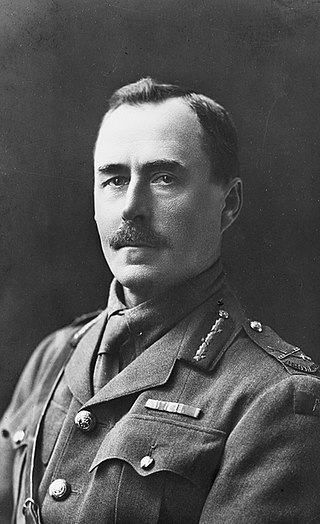
James Heane, was an Australian Army colonel and temporary brigadier general in the First World War. He retired in 1935 as a brigadier.

The 5th/6th Battalion is one of two battalions of the Royal Victoria Regiment, and is an infantry battalion of the Australian Army. The battalion traces its lineage back to many units that existed prior to Federation, as well as units that fought during World War I and World War II and the battalion carries the battle honours of these units as a mark of respect. Today 5/6 RVR is part of the 4th Brigade, 2nd Division and is based at various depots around Melbourne, Victoria. Recently, members from the battalion have been involved in deployments to the Middle East, East Timor, the Solomon Islands and Malaysia as part of Rifle Company Butterworth.

The 2nd Battalion was an infantry battalion of the Australian Army. It was initially raised for service during the First World War as part the Australian Imperial Force and saw action at Gallipoli before being sent to the Western Front in mid-1916, where it spent the next two-and-a-half years taking part in the fighting in the trenches of France and Belgium. Following the conclusion of hostilities, the battalion was disbanded in early 1919 as part of the demobilisation process.

Brigadier-General Henry Normand MacLaurin was an Australian barrister and an Australian Army colonel who served in the First World War. He was shot dead by a Turkish sniper at Gallipoli, and was posthumously promoted to brigadier general when all brigade commanders in the Australian Imperial Force were thus promoted.
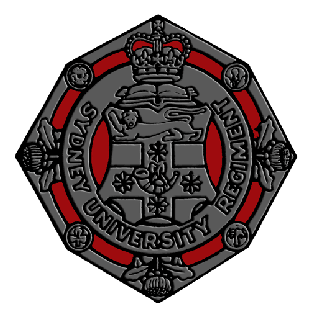
Sydney University Regiment (SUR) is an officer-training regiment of the Australian Army Reserve. Its predecessor, the University Volunteer Rifle Corps, was raised in 1900 as a unit of the colonial New South Wales Defence Force. During the 20th century, several changes of name and role occurred. Sydney University Regiment is headquartered in Holsworthy Barracks and has detachments in Sydney, Canberra and Wollongong.

41 Canadian Brigade Group is a Canadian Army formation of the 3rd Canadian Division. The formation is composed of Army Reserve units within the province of Alberta and the Northwest Territories. The headquarters of the brigade is in Calgary.

The 2nd/17th Battalion, Royal New South Wales Regiment is a reserve infantry battalion of the Australian Army. Currently part of the 5th Brigade, attached to the 2nd Division, the unit currently consists of a headquarters, signals platoon and three rifle companies spread out across a number of depots throughout the state of New South Wales. The unit was formed in 1987, following a reorganisation of the Australian Army Reserve which saw the amalgamation of a number of Reserve units across Australia. Through the 2nd Battalion and the 17th Battalion, the unit can trace its lineage back to 1860 and today it carries battle honours from both of these units, as well as the units of the Second Australian Imperial Force which fought during World War II.

The British Expeditionary Force order of battle 1914, as originally despatched to France in August and September 1914, at the beginning of World War I. The British Army prior to World War I traced its origins to the increasing demands of imperial expansion together with inefficiencies highlighted during the Crimean War, which led to the Cardwell and Childers Reforms of the late 19th century. These gave the British Army its modern shape, and defined its regimental system. The Haldane Reforms of 1907 formally created an Expeditionary force and the Territorial Force.

8th Brigade is an Australian Army Reserve training formation. It is headquartered in Sydney, and has subordinate units in various locations around New South Wales and the rest of Australia. These units are tasked with delivering basic and initial employment training to Reserve soldiers.

The 1st/19th Battalion, The Royal New South Wales Regiment is an infantry battalion of the Australian Army. It is one of four battalions of the Royal New South Wales Regiment and is currently a Reserve unit attached to the 5th Brigade, 2nd Division. In its present form 1/19 RNSWR was initially raised in 1967 as 19th Battalion The Royal New South Regiment under the Command of LTCOL Thomas Joseph Crawford MBE ED. In 1971 following the reduction of 1st Battalion, Royal New South Wales Regiment (Commando) from Battalion strength to Company strength 19th Battalion was amalgamated with 1st Battalion and designated as 1st/19th Battalion RNSWR.These two units were previously linked between 1930 and 1939, although they can trace their lineage back to 1854 with the formation of a number of Volunteer Rifles units as part of the New South Wales colonial defence force. The battalion's headquarters is located in Romani Barracks, Orange, with four rifle companies spread across Wagga Wagga, Bathurst, Dubbo, and Canberra.
Major General Paul Le Gay Brereton, is a Judge of the New South Wales Court of Appeal and a senior officer in the Australian Army Reserve. He commanded the 5th Brigade from 2008 to 2010 and Head of the Cadet, Reserve and Employer Support Division from 2010 to 2014. He led an Inspector-General of the Australian Defence Force investigation into criminal misconduct on the battlefield by Australian Special forces in Afghanistan, issuing the Inspector-General of the Australian Defence Force Afghanistan Inquiry Report in November 2020. In March 2023, he was appointed as the inaugural commissioner of the National Anti-Corruption Commission.
The 1940 Birthday Honours were appointments by King George VI to various orders and honours to reward and highlight good works by citizens of the British Empire. The appointments were made to celebrate the official birthday of The King, and were published on 9 July 1940.
The 1917 Birthday Honours were appointments by King George V to various orders and honours to reward and highlight good works by citizens of the British Empire. The appointments were made to celebrate the official birthday of The King, and were published on 4 June and 19 June.

The London Guards is a formation within the British Army comprising the reserve companies of the Grenadier, Coldstream, Scots and Irish Guards. On formation these companies drew their personnel from the London Regiment and it traces its history back to the formation of that regiment in 1908 when 26 separate Volunteer Force battalions were brought together. The London Guards is not a regiment, the companies wear the uniform, and follow the traditions, of their foot guards regiment.






















